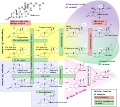This is an old revision of this page, as edited by CheMoBot (talk | contribs) at 16:04, 16 February 2012 (Updating {{drugbox}} (no changed fields - added verified revid - updated 'UNII_Ref', 'ChEMBL_Ref', 'ChEBI_Ref', 'KEGG_Ref') per Chem/Drugbox validation (report errors or [[user talk:CheM...). The present address (URL) is a permanent link to this revision, which may differ significantly from the current revision.
Revision as of 16:04, 16 February 2012 by CheMoBot (talk | contribs) (Updating {{drugbox}} (no changed fields - added verified revid - updated 'UNII_Ref', 'ChEMBL_Ref', 'ChEBI_Ref', 'KEGG_Ref') per Chem/Drugbox validation (report errors or [[user talk:CheM...)(diff) ← Previous revision | Latest revision (diff) | Newer revision → (diff) Pharmaceutical compound | |
 | |
| Pharmacokinetic data | |
|---|---|
| Metabolism | Adrenal, Gonads |
| Identifiers | |
IUPAC name
| |
| CAS Number | |
| PubChem CID | |
| ChemSpider | |
| CompTox Dashboard (EPA) | |
| ECHA InfoCard | 100.006.239 |
| Chemical and physical data | |
| Formula | C21H32O3 |
| Molar mass | 332.48 g/mol g·mol |
| 3D model (JSmol) | |
| Melting point | 268 °C (514 °F) |
SMILES
| |
InChI
| |
| (verify) | |
17-Hydroxypregnenolone (also 17-OH-pregnenolone and 17α-hydroxypregnenolone), is a C21 steroid that is obtained by hydroxylation of pregnenolone at the C17α position. This step is performed by the mitochondrial cytochrome P450 enzyme 17α-hydroxylase (CYP17A1) that is present in the adrenal and gonads. Peak levels are reached in humans at the end of puberty and then decline. High levels are also achieved during pregnancy.
Prohormone

17-OH-pregnenolone is considered a prohormone in the formation of dehydroepiandrosterone (DHEA), itself a prohormone of the sex steroids.
This conversion is mediated by the enzyme 17,20 lyase. As such 17-OH-pregenolone represents an intermediary in the delta-5-pathway that leads from pregnenolone to DHEA. 17-hydroxypregneolone is also converted to 17-hydroxyprogesterone, a prohormone for glucocorticosteroids and androstenedione through the activity of 3-hydroxysteroid dehydrogenase.
Neurohormone
There is some evidence that 17-OH-pregnenolone may have activity as a neurohormone.
Clinical use
Measurements of 17-OH-pregnenolone are useful in the diagnosis of certain forms of congenital adrenal hyperplasia. In patients with congenital adrenal hyperplasia due to 3 beta-hydroxysteroid dehydrogenase deficiency 17-OH-pregnenolone is increased, while in patients with congenital adrenal hyperplasia due to 17 alpha-hydroxylase deficiency levels are low to absent.
See also
Congenital adrenal hyperplasia
Additional images
References
- Hill, M; Lukác, D; Lapcík, O; Sulcová, J; Hampl, R; Pouzar, V; Stárka, L (1999). "Age relationships and sex differences in serum levels of pregnenolone and 17-hydroxypregnenolone in healthy subjects". Clinical chemistry and laboratory medicine : CCLM / FESCC. 37 (4): 439–47. doi:10.1515/CCLM.1999.072. PMID 10369116.
- Matsunaga, M; Ukena, K; Baulieu, EE; Tsutsui, K (2004). "7α-Hydroxypregnenolone acts as a neuronal activator to stimulate locomotor activity of breeding newts by means of the dopaminergic system". Proceedings of the National Academy of Sciences of the United States of America. 101 (49): 17282–7. doi:10.1073/pnas.0407176101. PMC 535386. PMID 15569930.
- Riepe FG, Mahler P, Sippell, Partsch CJ. Longitudinal Study of Plasma Pregnenolone and 17-Hydroxypregnenolone in Full-Term and Preterm Neonates at Birth and during the Early Neonatal Period. The Journal of Clinical Endocrinology & Metabolism (2002) 87: 4301-4306
| Cholesterol and steroid metabolic intermediates | |||||||||||
|---|---|---|---|---|---|---|---|---|---|---|---|
| Mevalonate pathway |
| ||||||||||
| Non-mevalonate pathway | |||||||||||
| To Cholesterol | |||||||||||
| From Cholesterol to Steroid hormones |
| ||||||||||
| Nonhuman |
| ||||||||||
